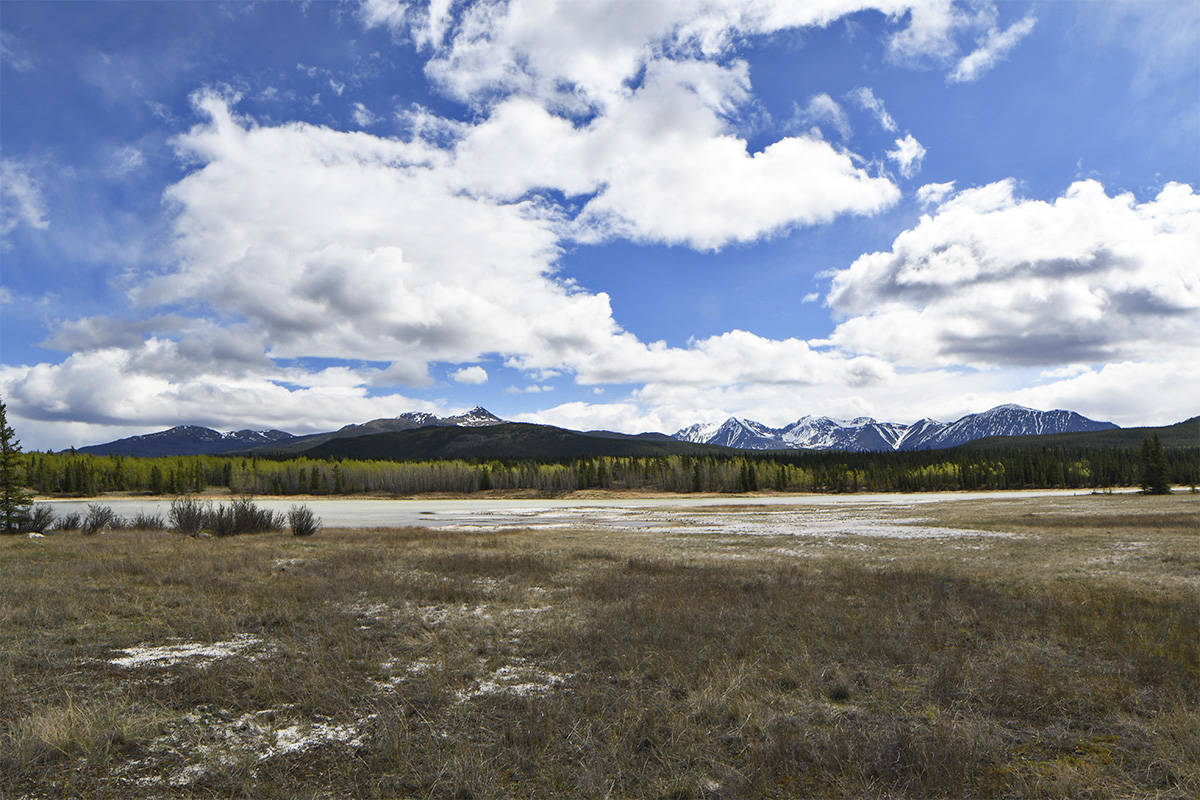It’s one of the Yukon’s best open geological secrets, a well-known but under-studied patch of land that’s home to biological oddities found in limited numbers, if at all, elsewhere in the North.
And chances are, if you live in or around Whitehorse, you’ve driven past it before.
The Takhini Salt Flats, located just north of the Alaska Highway about one kilometre before the Takhini River bridge, are a relatively new phenomenon, according to Jeff Bond, the manager of surficial geology at the Yukon Geological Survey.
Aerial photos taken in 1940 show a large lake in the area, Bond said — one that no longer exists, or at least not in its entirety.
That lake, known as Two Horsemen, as well as the present-day salt flats, are both the remnants and result of an even larger ancient glacial lake, Champagne, that flooded the Takhini valley during the end of the last ice age.
“Many, many metres of salts and sands and clay” were deposited into the lake, Bond explained, with the different layers of sediments still visible in some places today. As lake sediments are very fine, they’re more likely to host permafrost, with some of that permafrost taking the form of large chunks of ice embedded within the sediments.
When that permafrost thaws, whether it’s because of climate change or forest fires, the sediments above collapse into the space left behind, forming depressions where water can pool.
The resulting bodies of water are called thermokarst ponds. Water doesn’t really drain from them; instead, it tends to mostly evaporate, which allows for all the salts the water picked up from the ground while draining into the depressions to be left behind.
In the Takhini Salt Flats’ case, Bond said, the two main salts are mirabilite and thenardite, both of which are sulphate-based.
Salt flats are “quite rare” in the Yukon, according to Bond, with the Takhini valley offering a perfect environment for their formation — combined with the thermokarst depressions and salt content of the sediments, the valley is one of the driest places in the territory, averaging only about 25 centimetres of precipitation a year.
The ponds have usually all evaporated by mid-summer, with the salt flats dry and exposed into the fall before getting blanketed in winter snow. As the snow melts in the spring, the cycle begins anew.
The unique milieu has made the Takhini Salt Flats home to an equally unique host of flora.
“It’s quite a remarkable combination of all sorts of things,” Bruce Bennett, Environment Yukon’s conservation data centre coordinator, told the News.
Bennett has been documenting plants and leading guided walks out to the Takhini Salt Flats for more than 20 years now, watching as various native grasses begin moving into the area. He first visited the site back in 1998, when he was called in to investigate reports that the person using the site as a horse-grazing pasture had dug barrels into the ground and half-filled them with oil to trap ground squirrels.
“I’d never seen anything quite like this,” he said of the salt flats.
(Along with ground squirrels, he found ducks and other creatures in the barrels; they were removed shortly thereafter. Ground squirrels remain a rare sight at the salt flats to this day.)
Among the unusual plants that thrive in the conditions of the Takhini Salt Flats are the saline saltbush, sartwell’s sage, saltwater cress and horned pondweed. Perhaps most peculiar, though, is the humble Arctic glasswort, or Salicornia borealis.
Also known as “sea asparagus” due to its vague resemblance to the speared vegetable, Arctic glasswort does something that no other plant Bennett is aware of does — it blooms internally, displaying no flowers to the outside world.
So odd is this feature, Bennett said, that a Salicornia expert from Nova Scotia once requested he send her flower samples, and, not believing that there were none, flew to the Yukon to examine it herself.
“I said, ‘Well, I’ve never seen it flower,’” he recalled. “And she says, ‘Oh, you’re just looking at the wrong times of the year.’ And I said, ‘I’ve been looking at it for decades and every month, and I’ve never seen a flower.’
“… It’s quite an anomaly.”
Although edible (“it’s kind of fun because you bite it and it tastes salty”) Bennett said he thought actually farming Arctic glasswort would be impractical, on account of the plant self-pollinating internally and then dying, with the new plants growing from the bodies of their dead parents.
Besides plants, the salt flats also attract impressive numbers of migrating shore birds in the spring, and is home to insects not found elsewhere in the Yukon (Syd Cannings, a species-at-risk biologist with the Canadian Wildlife Service, told the News that “there’s lots of shore flies, which I’ve tried to get somebody interested in.”)
On recent concerns that visiting the Takhini salt flats might pose a risk to the ecosystem, Bennett said that wasn’t really a concern; ATVs, which do the most damage to landscapes, don’t seem to be used much in the area, and the potential nearby development of agricultural plots would pose a far larger threat.
“When I first started doing walks out there, you know, 20 years ago or something, people said, ‘Is there anything that would be harmed by trampling?’” he said.
“And I’ve said, ‘Well, if there’s anything that could be harmed by trampling, it’s already gone, right?’ Because the horses had really just hammered the site. So everything there is pretty resistant, especially to things like hiking and walking.”
Read about the purple sulphur bacteria that live in what remains of Two Horsemen Lake, right next to the salt flats, here.
Contact Jackie Hong at jackie.hong@yukon-news.com

